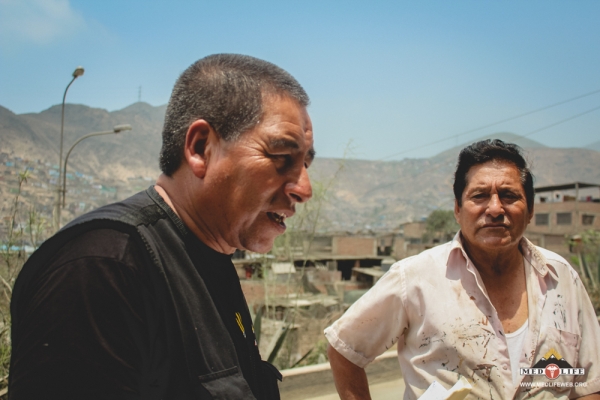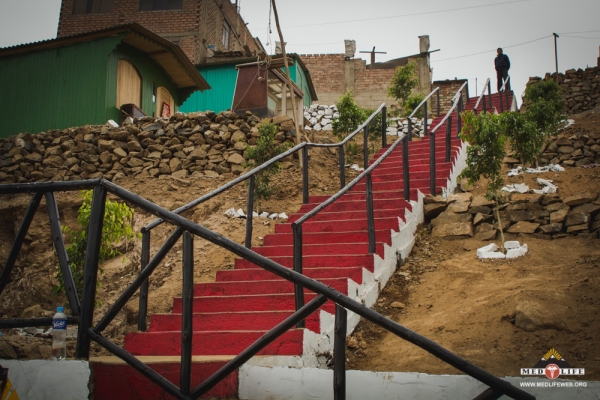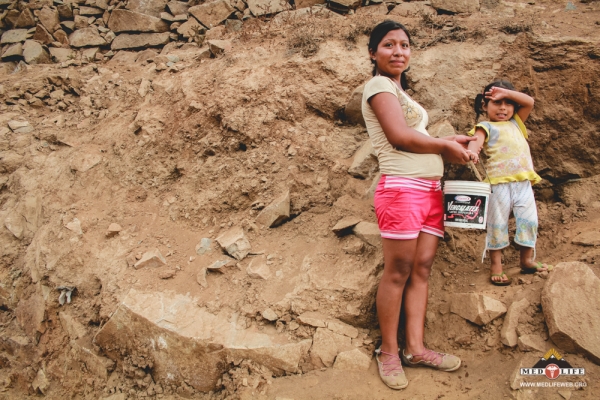Director of MED programs Carlos Benavides stood on a steep dirt path in Paraiso, a community where MEDLIFE has never done a project before. It was daytime and the deplorable living conditions in the pueblos jovenes were in full view.
When MEDLIFE enters a new community, it is often necessary to start from scratch. Sometimes people have never heard of the organization. MEDLIFE may not have any contacts with the leaders of the community, if there are any. So how does MEDLIFE get to the point where a specific problem is identified, and we have engaged with the community enough to organize a community meeting?
Often, engaging the community starts in the simplest way possible: visiting the community, approaching people in the street, knocking on doors, explaining to them what MEDLIFE is, and listening to their needs.
Carlos was in Paraiso on one of those preliminary visits. He was scouting out the dirt path for the construction of a small stair-case. It will benefit many families, but MEDLIFE is making it primarily for a specific patient, known as Pompinchu, a famous comic with osteoporosis and a broken leg. He can only walk with a walker, and MEDLIFE is trying to make the walk up the hill to his home safe for him and his neighbors.
No one said hello on the walk up to Pompinchu’s house, it was up to Carlos to take the first step and engage the community. “Do you know what MEDLIFE is?,” Carlos asked over and over. The response was always no. He would stop them, explain what MEDLIFE is and why MEDLIFE wants to build a staircase in the community. Then he gave them his card, asked them to spread the word about the project and help organize a community meeting. Hopefully they would actually call.
Next, he went to speak with the people who would be directly impacted by the project.
Pompinchu’s house is in the middle of a row of shacks mostly constructed out of wood and corrugated iron siding on a steep hill; I wonder how they don’t slide off.
Carlos knocks on a neighbors door. A middle-aged man answers, and Carlos asks him what he thinks of the staircase project. Would it benefit him too? Is there a real need for it?
The neighbor replies that the need for a staircase is great when it rains a lot. “When the land is wet, it is like soap,” he said. “It is always a problem for my family too. There have been enough accidents here.” MEDLIFE will have to get rid of some of the plants in the path that he has planted. He doesn’t care, but it is important to bring up these sorts of things with community members who will be directly affected by a project.
Carlos asks him to talk with other people in the community to help organize a meeting to discuss the project. He agrees and takes the card.
The row of shacks that the staircase will lead to sits beneath a concrete two-story home that towers above the shacks surrounding it like a bizarre monument, a constant reminder that another life is possible here. The shacks would shock most people who have never visited a slum while the two-story home would not look out of place in a lower middle class neighborhood in the US.
Carlos pauses, looks up at the large home and begins to talk about why it is so important to help a community to self-organize. It was as if he was trying to answer the obvious question that enters ones mind when wealth and poverty are so sharply contrasted: why aren’t people helping one another more within the community? It is clearly possible for people to work together to make life better for the community and for every living in it- but it hasn’t happened.
“The problem is self-organization, communication; [getting people] to come together and work hard is quite difficult,” Carlos said as he glanced back up to the concrete house above the row of makeshift shacks.
“For example, you see that two-story house- there are the socioeconomics of life. He stayed here and progressed here. People don’t organize themselves well so we need to help them, motivate them, and say to them that it’s oneself who changes their own life. We make staircases, plant plants, paint them, make handrails, everything, everything we do, it is just in five days and here it is –a great staircase.”
All it takes is five days of people working together to make a long-term impact on the quality of life of the community. While MEDLIFE pays for building materials, designs projects, and brings volunteers to help with some construction, it is ultimately the community that actually builds most of the staircase.
Before we leave Carlos tells Pompinchu’s neighbor again to please call and tells him that “we can build it if there is not a problem mobilizing the community.”
Later that day he headed to another community, 15-A1. MEDLIFE has already built a staircase and held clinics here. Here the community is engaged and organized. They already helped MEDLIFE build a staircase. Now, MEDLIFE is working on building a water pylon, so that the community can have access to cheaper water, and so they don’t have to carry water bucket by bucket up the steep hillside to their homes.
The difference between 15-A1 and is immediately apparent. Everywhere we go people stop Carlos to thank him for the staircase, discuss working on the water project, or to just say hello. The people in 15-A1 already know about the development projects happening in their town; Carlos doesn’t have to tell them about the water pylon. Many of them tell Carlos that he can count on them to be there to help construction.
A pregnant woman holding a crying baby stops Carlos to tell us how hard it is for women with small children to carry the buckets of water up the hill, how she doesn’t want her children to have to drink water full of dead flies and fungus.
This community is engaged and rallying around the project, and things are happening. A community meeting is being organized by several contacts who came to meet us and discuss the project.
But it takes time to get to this point. It starts small. It starts with getting a few people in a community like Paraiso to spread the word and work with MEDLIFE to make a project happen.
At the bottom of the hill Carlos hails a moto-taxi, he knows the driver. He mentions how difficult it is living without any light in the community he lives in that is visible through the moto-taxi window on the adjacent hillside. “This town needs lights, this town needs water, it is different everywhere,” Carlos said.
Carlos tells him he will talk to some people; maybe MEDLIFE can do a project to put lighting in his town.




